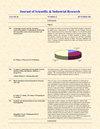An Insight into the Performance of Chaotic Sequences using Cascaded Mismatched Filters with Adaptive Performance of Radar Sequences using Adaptive Mismatched Filter
IF 0.8
4区 工程技术
Q3 ENGINEERING, MULTIDISCIPLINARY
引用次数: 0
Abstract
In modern Radar applications, optimal sequences have been used in many areas, such as communication systems, radar, and sonar, because of their minimal peak sidelobe level, which causes an increase in the signal-to-noise ratio with a good range resolution at the output. The literature survey shows various pulse compression techniques that are widely used to achieve superior range resolution and range detection performance. Several studies have been conducted on chaotic communication involving chaotic maps in recent years, producing promising results. These maps are used to generate different phase-coded sequences. The properties of the chaotic map sequences are almost random. The performance of these sequences has been studied with various optimization techniques in literature by employing a matched filter and a mismatched filter and is measured in terms of peak sidelobe ratio. But the performance has not improved significantly. This paper focused on improving performance using a new hybrid technique to design mismatched filters. This improvement is achieved by designing the coefficients of the mismatched filters using a combination of metaheuristic methods and an evolutionary algorithm for specializing in intensification and diversification. A significant improvement in the peak sidelobe ratio and range resolution is obtained when the mismatched filter is combined with adaptive filters at the output.利用级联失匹配滤波器对混沌序列的性能与雷达序列自适应失匹配滤波器的自适应性能的探讨
在现代雷达应用中,最优序列已用于许多领域,如通信系统,雷达和声纳,因为它们的最小峰值旁瓣电平,这会导致信号噪声比的增加,并在输出端具有良好的距离分辨率。文献综述显示了各种脉冲压缩技术被广泛用于实现良好的距离分辨率和距离检测性能。近年来,人们对混沌映射的混沌通信进行了一些研究,并取得了可喜的成果。这些图用于生成不同的相位编码序列。混沌映射序列的性质几乎是随机的。这些序列的性能已经在文献中通过使用匹配滤波器和不匹配滤波器的各种优化技术进行了研究,并根据峰值旁瓣比进行了测量。但性能并没有显著提高。本文的重点是利用一种新的混合技术来设计不匹配滤波器,以提高其性能。这种改进是通过使用元启发式方法和专门用于强化和多样化的进化算法的组合来设计不匹配滤波器的系数来实现的。将失匹配滤波器与输出端自适应滤波器相结合,显著提高了峰值旁瓣比和距离分辨率。
本文章由计算机程序翻译,如有差异,请以英文原文为准。
求助全文
约1分钟内获得全文
求助全文
来源期刊

Journal of Scientific & Industrial Research
工程技术-工程:综合
CiteScore
1.70
自引率
16.70%
发文量
99
审稿时长
4-8 weeks
期刊介绍:
This oldest journal of NISCAIR (started in 1942) carries comprehensive reviews in different fields of science & technology (S&T), including industry, original articles, short communications and case studies, on various facets of industrial development, industrial research, technology management, technology forecasting, instrumentation and analytical techniques, specially of direct relevance to industrial entrepreneurs, debates on key industrial issues, editorials/technical commentaries, reports on S&T conferences, extensive book reviews and various industry related announcements.It covers all facets of industrial development.
 求助内容:
求助内容: 应助结果提醒方式:
应助结果提醒方式:


